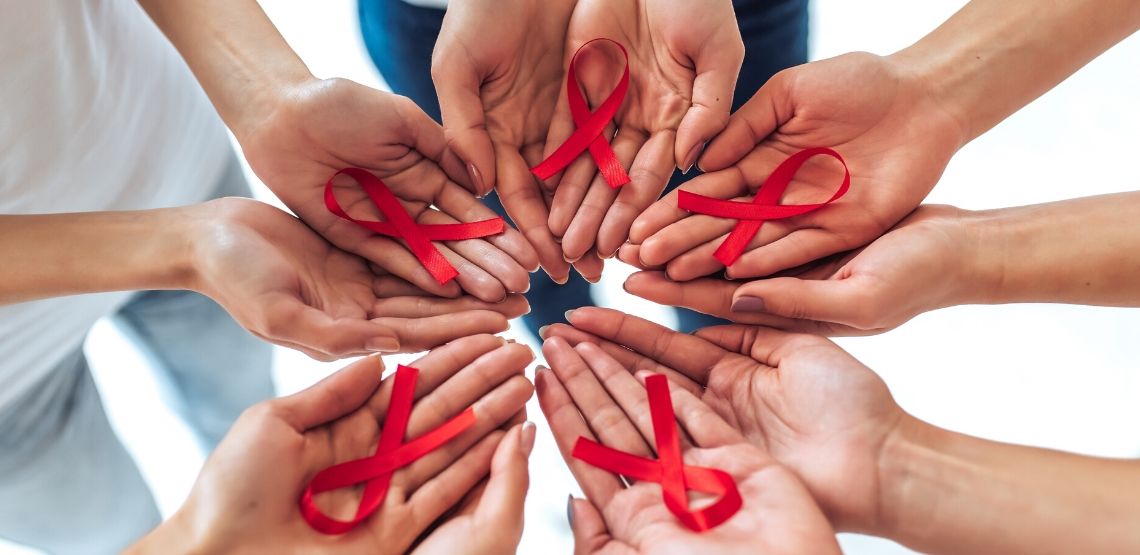Difference Between HIV and AIDS
While some people may think HIV and AIDS are the same thing, they are in fact different. HIV stands for Human Immunodeficiency, and if left untreated, can lead to AIDS (Acquired Immuno-Deficiency Syndrome). AIDS is the final stage of HIV and occurs when a person’s immune system cannot fight off even the weakest infections.
When HIV first became widespread in the 1980s, it was a death sentence because untreated HIV progresses to AIDS within five to 10 years.
However, the treatment options available today did not exist then. Now someone with HIV can live as long as someone without HIV. Most people with HIV in the United States do not develop AIDS if they receive treatment.
Facts to Clear up Common Misconceptions
- You cannot get HIV from kissing, sitting on a toilet seat, or hugging.
- You cannot get HIV from an insect bite or from someone coughing.
- HIV has no cure, but treatment can keep it dormant permanently.
- HIV spreads mostly through unprotected sex and sharing needles.
Why the Term AIDS is as Popular as HIV
AIDS is in fact stage three HIV, yet it is as famous as HIV itself. This is because AIDS was discovered, or at least named, before HIV.
AIDS was once called GRID, as in Gay-Related Immune Deficiency. Then, scientists found out anyone could get GRID, so the name was changed to AIDS.
The Stages of HIV
Stage one: Acute HIV
This is the first stage of HIV. It occurs within two months of initial HIV infection. Usually within two to four weeks.
During this stage, HIV spreads throughout your entire body before being trapped in your lymph nodes. Most people have flu like symptoms for up to four weeks. Some people have no symptoms.
After HIV infects the body, it enters the CD4 cells (white blood cells) of its host. CD4 cells are what your immune system uses to keep you healthy. HIV uses the infected CD4 cells as a base to grow. While HIV grows, it destroys the CD4 cells in the process.
HIV would be easier to cure if it did not hide in the cells. CD4 cells can activate, get infected by HIV and then deactivate before HIV grows inside them. HIV medicine is unable to affect HIV hidden in deactivated CD4 cells. The deficiency will not try to attack again until the amount of HIV antibodies and HIV medicine lowers in your bloodstream.
This is why HIV lives beyond stage one.
Stage two: Clinical Latency
At this stage, HIV is dormant. The human body has produced enough HIV antibodies to force the HIV virus to hide.
Without treatment, stage two HIV can last five to twenty years before progressing to AIDS. With treatment, stage two can be permanently prevented from progressing to AIDS.
There are no symptoms during stage two HIV, unless it begins to progress towards AIDS. As HIV gets closer to stage three, new infections become more likely.
Stage Three: AIDS
A person has AIDS when their CD4 cell count falls below 200. (A healthy person has a CD4 cell count of at least 500.)
If an HIV-positive person develops an “opportunistic infection” they have AIDS, regardless of their CD4 cell count.
Opportunistic infections are infections anyone can get. Except when you have HIV, they occur more often and are more severe.
Opportunistic infections include, but are not limited to:
- Tuberculosis. An infection commonly found in the lungs.
- Pneumonia. An infection which inflames the air sacs in one or both of your lungs.
- Candidiasis (thrush). A fungal infection common in the mouth and vagina.
- Herpes simplex virus. A viral infection causing cold sores in or around your mouth. It also causes ulcers on or around your genitals or anus.
Related Search Topics (Ads)
HIV Symptoms vs AIDS Symptoms
In stage one, the fight against HIV overwhelms your body temporarily. In stage three, HIV has killed enough of your immune cells, making infections more likely and harder to fight off.
Unlike stage one HIV, AIDS is not the direct source of any symptoms. Instead, AIDS makes it more likely for you to get new infections, causing new symptoms and problems.
HIV Treatment Options and Costs
All HIV-positive individuals should start treatment immediately after receiving an HIV diagnosis.
Treating HIV is expensive. It requires paying for large amounts of medications and several doctor visits per year. Then, there are lab tests done year after year. The costs add up to over $20,000 a year on average. There are government programs that offer assistance to qualifying individuals.
HIV treatment involves the use of many medications, known as antiretroviral therapy, or ART. ART is the universal treatment for HIV. HIV medications have five main classes. Among the five main classes, there are over 30 unique medications available for treating HIV.
Nucleoside or Nucleotide Reverse Transcriptase Inhibitors (NRTIs)
After infecting a new CD4 cell, the RNA of HIV converts into DNA, a process known as reverse transcription. NRTIs stop the conversion by turning off a protein HIV needs, thus preventing HIV from growing.
Non-nucleoside Reverse Transcriptase Inhibitors (NNRTIs)
These work nearly the same way as NRTIs. They stop the conversion of RNA into DNA by binding to an enzyme involved in the process.
Protease Inhibitors (PIs)
PIs work by blocking the activity of an enzyme HIV needs to grow functioning copies of itself. HIV is able to grow when affected by PIs, but the copies it makes are immature and cannot copy themselves.
Entry Inhibitors
Entry inhibitors prevent HIV from entering human cells. This class of HIV medication is a last resort in most cases since it is ineffective compared to other classes.
Integrase Inhibitors
By disabling a protein called integrase, integrase inhibitors prevent HIV from injecting its viral DNA into the chromosomes of a human cell. Blocking the injection can prevent the spread of HIV to other cells.


